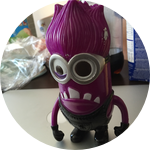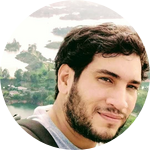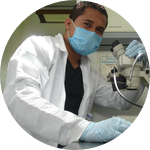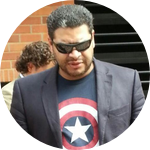Project Results
Hello everyone, I hope you are very well, I tell you that we perform hemolysis tests, antimicrobial tests and antitumor tests with PC3 cells, which are prostate cancer.
We found 2 peptides with antimicrobial and antitumor activity, and one of them had no cytotoxic effect against the control that were HACAT cells (human keratinocytes), these peptides are derived from DS4.3, a peptide with cell penetrating activity already reported.
On June 22-27, 2019 they were exposed at the American Peptide Symposium together with the results of simulations where the stability of the peptide in the E.coli membrane model is corroborated.
We finish the first manuscript where we will publish the de novo transcriptome of Boana pugnax and we are finishing the flow cytometry where we will see in detail how the two peptides mentioned above acted in the tests of apoptosis and cell cycle.
We appreciate your collaboration and support in this project.
NEW PEPTIDES FROM DE NOVO ASSEMBLY TRANSCRIPTOME OF THE SKIN OF TREEFROG BOANA PUGNAX
Liscano y. Arenas CM, Gúzman f, Pickholz M, Delgado JP
Poster
About This Project
The search for alternative antibiotics is on, due to widespread resistance to current antibiotics. We will use bioinformatic and molecular analysis to determine if there are peptides with antimicrobial activity in the skin of the Colombian frog (Hypsiboas pugnax). We believe that the dorsal region of this frog’s the skin, due to terrestrial and predator contact, produces wide variety of antimicrobial peptides.
Ask the Scientists
Join The DiscussionWhat is the context of this research?
Currently, conventional antibiotics present resistance problems, which has encouraged the search for alternatives. Some of these peptides are also thought to have the advantage of presenting multiple activities, not only combating bacteria, but also stimulating the immune system, promoting healing and with anticarcinogenic activity.
The Colombian frog is located in the department of Antioquia, Colombia. There are currently no reports about bioactives substances found in this area. The Colombian frog is arboreal, and very sensitive to changes in temperature and climate. Additionally, it has a variety of predators and surfaces that it comes into contact with. We believe that the diversity of substances it comes into contact with will make the skin more likely to produce peptides.
What is the significance of this project?
Through this project I am testing a new method to find and predict bioactive peptides without sacrificing animals as conventional proteomics does today. Also I believe we will find new antibiotics with broad spectrum utility and multiple activities (e.g. anticancer and wound healing).
The results of this project will teach us more about Colombian biodiversity and its biopharmaceutical potential. These findings will shed more light on the Colombian frog’s genetic background and could lead to the identification of new peptide with therapeutic characteristics, presenting advantages like broad spectrum of activities and low bacterial resistance compared to conventional antibiotics
What are the goals of the project?
Our main goaI is to identify and characterize candidate peptides with multiple activities from the skin of a Colombian frog.
We will be assembling de novo transcriptome of the frog skin and predicting the probable peptides with antibacterial activities. We will do so by making comparisons to peptide databases and screening candidates through physicochemical characteristics such as net charge, hydrophobicity, and penetrability (important features of compounds that we know to be antimicrobial). We will then synthesize the candidates and carry out an antimicrobial assay on identified peptides to test them.
Budget
These items are important to verify the presence of the peptides in the skin of the frog and to synthesize them and carry out the functional analyzes (antimicrobial, antitumor)
Endorsed by
 Project Timeline
Project Timeline
The funds for this part of the project will allow me to begin ordering the necessary supplies to have a PCR to to correlate the predicted peptides with those that are actually present in the skin of the frog (May) and to obtain the peptides candidates for June and start antimicrobial, antitumor and wound healing tests. Once the data is analyzed, I will write a manuscript that describes the project overall.
Mar 06, 2018
Project Launched
Mar 30, 2018
Project Launched
Apr 30, 2018
Order lab supplies
May 15, 2018
Complete PCR for every sample
Jun 15, 2018
Peptide synthesis
Meet the Team
Affiliates
Affiliates
Affiliates
Yamil Liscano
I am a Ph.D. in biotechnology, I have been working with the design of peptides with computational tools and artificial intelligence. I am a professor at the faculty of the health of the university Santiago de Cali.
I have been passionate about research since I was very young. I ended up developing an interest in frog skin peptides in my master's degree. I realized the potential of these peptides and continue to try to find alternatives to fight cancer, antimicrobial resistance, and improve people's health. Now as a researcher I am encouraging my students to take part in projects with a social, economic, and scientific impact. Thanks to this platform I have the perfect opportunity to continue researching these interesting topics.
Claudia Marcela Arenas Gómez
I am a PhD candidate at the University of Antioquia. I have performed transcriptomic data analysis during limb regeneration in a Colombian Salamander (Bolitoglossa ramosi).
Belfran Carbonell Medina
I am PhD student in Biological Sciences at the University of Antioquia,Colombia. I am currently studying the cellular and molecular mechanisms of regenerative biolgy in the axololt.
jean paul delgado
Colombia is considered to be country with the second biodiversity of the planet, with almost 62.829 species and counting, Colombia houses 805 species of amphibians. Making of Colombia the second country in number of amphibians after Brazil.
The passion for science, mainly for biology, guided me to follow studies in biology in Colombia during the 90s. Soon after I finished my undergraduate training in Biology, I traveled to France to continue with my scientific training, accomplishing a master’s degree in experimental surgery and a PhD in cell signaling for my work in cell therapy for liver diseases at the University Paris XI in the year 2006.
In 2007, I realized that regenerative medicine is still far for being a bench side technology for the humankind; this motivated me to move to work on regenerative biology. I have had the amazing opportunity of working as a postdoctoral fellow at the University College of London (UCL), UK, under the mentorship of professor Jeremy Brockes, a world leading expert in salamander limb regeneration.
In the year 2011 I came back to Colombia to set up my lab and started my career as independent PI, at the Institute of Biology of the University of Antioquia. Currently my lab focuses in the study of amphibians of the biodiversity, mainly Plethodontid salamanders and tree frogs.
Nowadays we are putting enormous efforts to identify, isolate and characterize new molecules form the skin of Colombian amphibians that could harbor anticancer and antimicrobial activity, and even molecules able to induce cell regeneration.
Additional Information
The identification of new (unreported) and already reported peptides using bioinformatics has been made, at this time money is needed for the confirmation of the sequence using PCR. For positive candidates we will do the chemical synthesis and we will check the antibacterial and anticancer activities.
For the moment we would need money to start with the confirmation and to synthesize them.
Project Backers
- 8Backers
- 100%Funded
- $6,001Total Donations
- $750.13Average Donation





